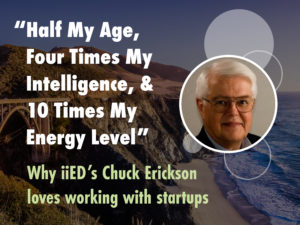I have been starting companies and teaching entrepreneurship for over two decades. I’ve been a team member for startup teams, I’ve started my own businesses, I’ve guided students to start their own businesses.
When I started teaching entrepreneurship in business school, I inherited a course that was designed to teach students how to write a business plan. How to do the research and analysis, how to assess the “feasibility” of their idea, design a product or service, write a “marketing plan” and create financial projections.
But I knew then that the PRACTICE of entrepreneurship was NOT THAT. Writing a business plan is important (and the rumors of the death of business plans are still premature) but writing a business plan is one specific task in starting a business and definitely not the most important one! So I redesigned the course to build it around the way businesses were REALLY being started.
Confronting The Old Marketing
Fast forward a few years. In my (new) entrepreneurship courses, I struggled with helping students create effective marketing plans suited to the businesses they were creating. They kept defaulting to developing marketing plans as they had learned in their introductory marketing courses, basing them on advertising as the primary tool, putting together arbitrary budgets that were not based on any useful metrics, and adding statements like “we will market our product/service using social media” – whatever that meant!
At the time, my own approach to marketing was still rooted firmly in what I had learned in the 1980’s—which was based on the amazing technologies of the 1950’s! TV, radio, and print-based mass-communications had given marketers the ability to reach tens of millions of consumers at the same time! These technologies led to the rise of marketing through brand development and mass advertising strategies that exploited the ability to communicate one-to-many where “many” was now measured in tens of millions.
But it’s no longer the 1950’s.
The 21st century has seen enormous changes in communications technology. These changes started with the “information age” revolution in the latter half of the 20th century but have developed far beyond the close of that century. These technology changes have deeply affected the way we live – the way we communicate, the way we shop, the way we find friends and lovers.
A phone (21st century) is not a phone (20th century). At the close of the 20th century, phones were still “telephones” – we used them to TALK to each other. Now, our phones are deeply embedded in our everyday lives.he LEAST thing we use them for is to talk to one another – that’s just so…20th century! We text, we get notified, we shop, we search, we learn, we manage our calendars, we announce to the world what we’re having for lunch, we keep in touch…all through our “phones” and mostly without ever actually making phone calls. Where we used to be searching for public pay phones, now we’re searching for wifi connections. Where we used to “call” one person at a time we now “post” to hundreds or thousands at the same time.
But this post isn’t about phones; it’s about marketing. It’s about how this revolution in communications has led to a revolution in marketing. And how we as marketers and entrepreneurs need to evolve to stay in step.
The 21st century marketing tools are more than just new, more powerful tools. They represent a whole new world of marketing technologies presenting new opportunities to connect with customers in entirely new ways.
New Tools
The internet, websites, Facebook, LinkedIn, Pinterest – these are where buyers are, and where they’re searching, deciding and buying. These are (some of) the new tools that have emerged in the 21st century.
The 21st century marketing tools have capabilities far beyond the one-to-many mass media technologies of the 20th century. We can now reach buyers by the billions instead of just by the tens of millions. We can reach the entire planet, limited more by government censorship than by technical limitations. And we can now reach them with text, voice, and video communications.
But the 21st century marketing tools are more than just new, more powerful tools. They are not just new places to “advertise.” They represent a whole new world of marketing, a new set of marketing communication technologies presenting new opportunities to connect with customers in entirely new ways, requiring an entirely new mindset for marketers.
These 21st century tools allow customers to ACT: to communicate back to us, to respond in real time, to buy in real time wherever they may be physically located. And that is a game-changer for marketers.
21st century marketing uses behavior-based marketing instead of attitude-based marketing; creates massive one-to-one conversations instead of one-to-many one-way communications; clicks not impressions; validation and experimentation not surveys.
Need New Tooling
We have to rethink how we approach the practice of marketing. Behavior-based marketing doesn’t look like attitude-based marketing. While we still want buyers to like us, what we REALLY want is to move buyers (potential buyers) through our marketing funnel from recruitment to conversion. We want existing buyers to remain engaged and repurchase. And so we have to our communications with buyers (not “to” buyers) to reflect those new objectives.
Harnessing these tools poses new challenges, new skills to learn, new strategies to follow – in short, these new tools mean marketers need to retool. We need new marketing tooling for this new century of marketing tools.
21st Century Marketing
So follow this space for more on 21st Century Marketing. I’ll be discussing (and looking for your responses and thoughts about) how marketing strategy, message content, and campaign implementation have to look in the new century. I’ll be referring to examples of 21st century marketing looks when its well-planned and well executed. My goal is to help you master the strategies and tools of 21st century marketing so that you, and we together, can become masters of 21st Century Marketing!
Brad Barbeau is a professor at California State University Monterey Bay School of Business, executive director of the Institute for Innovation and Economic Development and founder of Ascend Business Design and Development.
Read more about the 21CM marketing system at LaunchitGrowit.com
SaveSave
SaveSave



